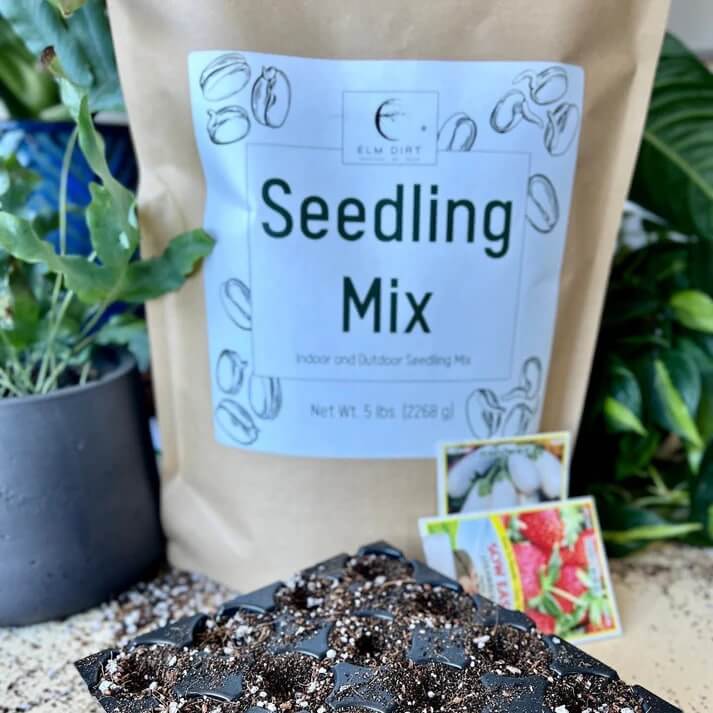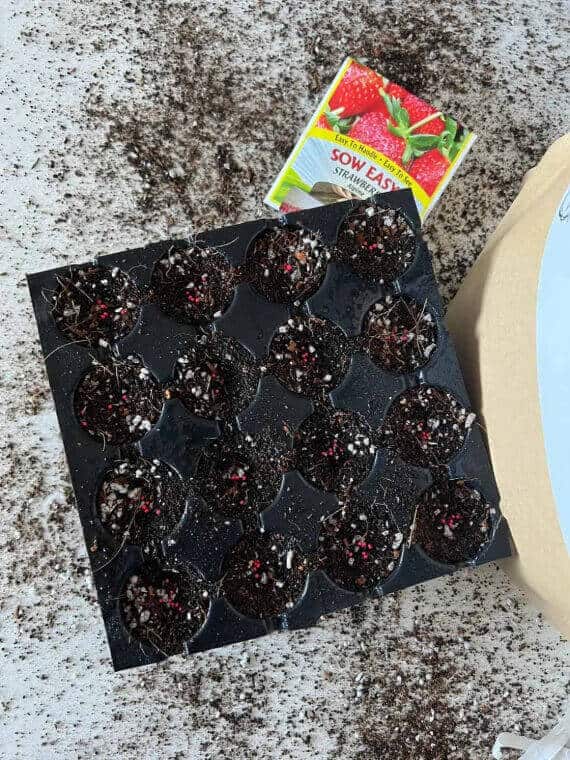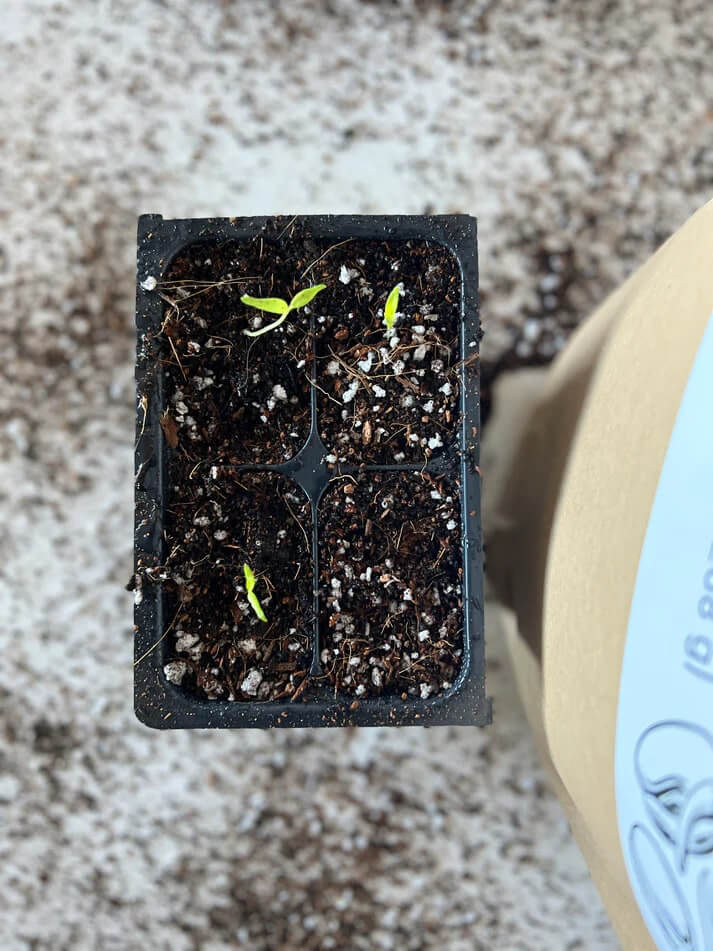Start Seeds Right the First Time
Here's the thing about starting seeds—most failures happen because people use regular potting soil. It's too heavy, too dense, and often way too rich for delicate seedlings. Seeds need something lighter and fluffier that they can actually push through.
This seedling mix is formulated specifically for germination. It's light enough for tiny seeds to sprout through, airy enough so seedling roots don't suffocate, and gentle enough that you won't burn tender new growth. Plus it's got Ancient Soil in it, which means beneficial microbes that protect against damping off—that awful fungal disease that kills whole trays of seedlings overnight.
You'll get better germination rates, stronger root systems, and seedlings that actually handle transplanting without wilting dramatically. Start your garden off right instead of having to redo everything three weeks in.

Why Seeds Need Different Soil
Seeds and seedlings have completely different needs than established plants. When a seed germinates, it's living off stored energy in the seed itself. That tiny emerging root is delicate—it needs to push through the soil easily without hitting obstacles. And once it sprouts, the seedling needs air circulation around its roots or it'll rot.
Regular potting soil is formulated for mature plants with developed root systems. It's too dense for seeds. The texture can crust over on top, trapping seeds underneath. And it often contains too much nutrition, which can actually burn seedling roots that aren't ready for it yet.
Seedling mix is finer, lighter, and fluffier. Water drains through it while still keeping things moist. Delicate roots can spread easily. And the nutrition level is gentle enough for brand-new plants.

What's in This Mix
Fine Texture Components
- Light, airy blend that seeds can push through
- Won't compact or crust over like heavy soil
- Provides air circulation around roots
- Drains well while retaining moisture
- Perfect particle size for delicate seedlings
The base of this mix is designed specifically for germination. Fine enough that even tiny seeds like lettuce or basil can sprout through it, but structured enough to support seedlings as they grow. It stays fluffy instead of compacting down.
Ancient Soil
- Beneficial microbes protect against damping off
- Gentle organic nutrition for early growth
- Natural growth hormones support root development
- Improves seedling vigor and transplant success
- Class A certified worm castings
This is what sets the mix apart from basic seed starting mixes. Ancient Soil adds beneficial biology that protects vulnerable seedlings when they're most at risk. The microbes colonize around roots and crowd out the fungi that cause damping off. Plus the gentle nutrition from worm castings supports healthy growth without overwhelming delicate roots.
Moisture Management
- Holds moisture consistently for germination
- Drains excess water to prevent rot
- Doesn't dry out too quickly
- Easy to rewet if it does dry out
- Maintains even moisture throughout tray
Seeds need consistent moisture to germinate—not soaking wet, not bone dry, just consistently damp. This mix hits that sweet spot. It holds enough water that seeds stay moist, but drains well enough that roots don't rot. Way easier to manage than mixes that either turn into a swamp or dry out in hours.
How to Use Seedling Mix
Step-by-Step Seed Starting
Starting seeds isn't complicated, but there are a few tricks that make a big difference.
- Fill trays loosely: Don't pack the mix down. Fill your seed trays or pots to just below the rim, leaving it light and fluffy. Packed soil defeats the whole purpose of using seedling mix.
- Plant seeds properly: Follow the depth on your seed packet. As a general rule, plant seeds about 2-3 times as deep as the seed is wide. Cover with a thin layer of seedling mix.
- Label everything: Seriously, label it. Write what you planted and the date. You think you'll remember which tray is which—you won't.
- Water carefully: Mist gently until water drains from the bottom, OR set trays in a shallow tray of water and let them soak from below until the surface looks moist. Bottom watering is gentler and won't wash seeds around.
- Provide proper conditions: Most seeds need warmth (70-80°F) and some need light to germinate while others need darkness. Check your seed packet. Once sprouted, almost all seedlings need bright light or they'll get leggy.
- Keep moist until germination: The mix should stay consistently damp (not soaking) until seeds sprout. After that, let the top dry slightly between waterings but don't let seedlings wilt.

The Damping Off Problem
If you've started seeds before, you've probably dealt with damping off. One day your seedlings look fine, the next morning they're flopped over at the soil line with a pinched, rotted stem. It's caused by fungi (usually Pythium or Rhizoctonia) that thrive in wet, warm conditions—exactly the environment seeds need to germinate.
Most seed starting mixes are sterile to avoid this, but sterile just means there's nothing bad AND nothing good. When pathogenic fungi do show up (and they will, from the air or water or your hands), there's nothing to stop them.
This mix takes a different approach. The beneficial microbes in Ancient Soil colonize around seedling roots and outcompete the bad fungi. They create a protective barrier during that vulnerable period right after germination. Combined with the mix's good drainage (fungi love waterlogged soil), you get way better seedling survival.
You can't completely eliminate damping off—the fungi are everywhere—but you can stack the odds in your favor with good mix, proper watering, and air circulation.
Pro tip: A small fan providing gentle air circulation around seedlings dramatically reduces damping off. The air movement dries the soil surface slightly (fungi hate that) and strengthens seedling stems. Just don't blast them—gentle breeze, not windstorm.
When to Transplant
Seedlings are ready to transplant when they've developed 2-4 true leaves (not counting the first cotyledon leaves that emerge) and are about 2-3 inches tall. They should have visible roots coming out the bottom of the cell or starting to circle the sides.
Don't wait too long. Once seedlings outgrow their space, growth slows down and they get leggy and weak. But also don't transplant too early—wait until they're sturdy enough to handle the move.
Most seedlings can stay in this mix for 4-8 weeks. Fast growers like tomatoes and cucumbers will be ready on the early side. Slower stuff like peppers might take longer. The plants will tell you—when growth noticeably slows despite good conditions, it's time to move them.

What Seeds Work Best
Vegetables
Pretty much all vegetable seeds do great in this mix. Tomatoes, peppers, eggplant, cucumbers, squash, melons, lettuce, kale, broccoli, cabbage—everything. Heat-loving stuff like tomatoes and peppers germinate faster with a heat mat underneath, but the mix works either way.
Herbs
Basil, parsley, cilantro, dill, oregano, thyme—all the common herbs start well in this mix. Basil is notoriously prone to damping off, so the beneficial microbes really help. Parsley is slow (2-3 weeks to germinate), but it'll get there.
Flowers
Annual flowers like zinnias, marigolds, cosmos, and sunflowers are super easy in this mix. Perennials work too, though many take longer to germinate. If you're starting petunias or other tiny-seeded flowers, just barely press them into the surface—they often need light to germinate.
Microgreens
The mix works well for microgreens if you're harvesting them young. Spread seeds densely on the surface, cover lightly, keep moist. They'll be ready to cut in 1-2 weeks depending on variety.
Common Seed Starting Mistakes
Planting Too Deep
This kills more seeds than anything else. Tiny seeds like lettuce or basil barely need covering—just press them into the surface. Bigger seeds like beans or squash can go deeper. When in doubt, plant about 2-3 times as deep as the seed is wide.
Not Enough Light
Once seedlings emerge, they need bright light—like, a lot of it. A sunny windowsill often isn't enough. Seedlings stretch toward light and get leggy and weak. If you don't have a super bright window, use a grow light. Keep it 2-4 inches above seedlings and leave it on 14-16 hours daily.
Overwatering
Keep the mix consistently moist, not soaking wet. Overwatering is the main cause of damping off and root rot. The surface can dry slightly between waterings once seedlings are established—just don't let them wilt.
Starting Too Early
There's a tendency to start seeds way too early because you're excited. But if you start tomatoes in January and can't transplant outside until May, you'll have massive root-bound plants that struggle when finally planted. Check your last frost date and count backward based on seed packet timing.
Forgetting to Harden Off
Seedlings grown indoors are soft and pampered. You can't just stick them directly in the garden. They need to be hardened off—gradually exposed to outdoor conditions over 7-10 days. Start with a few hours of shade, gradually increase sun and outdoor time. Otherwise they'll get scorched or stressed.
Temperature matters: Most seeds germinate best at 70-80°F. If your house is cold, use a heat mat under the trays. Once seedlings emerge, many actually prefer slightly cooler temps (60-70°F) to prevent legginess. Warm for germination, cooler for growth.
How Much Do You Need?
A little goes a long way with seed starting. A 3-quart bag of Seedling Mix will fill:
- About 4-6 standard 72-cell seed starting trays
- Or 50-60 individual 3-inch pots
- Or 2-3 standard 1020 seed flats if you're broadcasting seeds densely
Most home gardeners can start a whole season's worth of seedlings with one bag. If you're starting hundreds of plants or doing multiple successions, grab a couple bags.
Watering Tips for Seedlings
Watering seedlings is tricky—they need consistent moisture but hate being waterlogged. Here's what works:
- Before germination: Keep consistently moist. Check daily. Some people cover trays with plastic domes or plastic wrap to maintain humidity.
- After germination: Remove any covers immediately. Let the top of the mix dry slightly between waterings, but don't let seedlings wilt.
- Bottom watering: Set trays in shallow water for 10-20 minutes until surface looks moist, then drain. Less risk of disturbing seedlings or encouraging surface fungi.
- Top watering: Use a gentle spray or watering can with a fine rose. Water until it drains from the bottom. Avoid blasting seedlings with a strong stream.
Why This Mix Works Better
We tested this mix against basic seed starting mixes and regular potting soil. The results were pretty clear:
- Better germination rates: Especially for finicky seeds like parsley and peppers
- Less damping off: The beneficial microbes make a real difference
- Stronger root systems: Seedlings develop more extensive roots in the light, airy texture
- Better transplant survival: The Ancient Soil seems to help seedlings handle the stress of transplanting
- Healthier overall growth: Seedlings just look more vigorous—deeper green, sturdier stems
The difference is most obvious with seeds that are prone to problems—like basil (damping off) or peppers (slow germination). But even easy stuff like tomatoes and zinnias just performs better.
Storage
Keep unused mix in the bag, sealed, in a cool dry place. It'll stay good for years. The microbial life goes dormant when dry and wakes back up when moistened. Even if it's been sitting for a while, it'll work fine—just mix it up a bit before using.
Don't reuse mix from previous seasons for seed starting. The structure breaks down, nutrients are depleted, and it might harbor pathogens. Add used mix to garden beds or compost bins. Fresh mix each season gives you the best shot at success.
Common Questions About Seedling Mix
What makes seedling mix different from regular potting soil?
Seedling mix is much lighter and fluffier than regular potting soil. Seeds need a fine texture they can push through easily, and delicate seedling roots need air circulation. Regular potting soil is too heavy and dense for germination—it can crust over or suffocate emerging seedlings. Seedling mix also has gentler nutrition that won't burn tender new roots.
Can I use this for all types of seeds?
Yes! This mix works for vegetable seeds (tomatoes, peppers, cucumbers), herb seeds (basil, parsley, cilantro), annual flowers, perennials, and even microgreens. The only exceptions are seeds that have very specific germination requirements (like those needing cold stratification or darkness).
How does this prevent damping off disease?
The Ancient Soil in this mix contains beneficial microorganisms that colonize around seedling roots and outcompete the fungi that cause damping off. These good microbes create a protective barrier while the seedling is most vulnerable. Combined with the mix's good drainage (fungi love wet conditions), you get much better seedling survival rates.
Do I need to add fertilizer when using this mix?
Not initially. The mix contains enough gentle nutrition from Ancient Soil to support seedlings through germination and early growth. Once seedlings have their first true leaves and are growing actively, you can start feeding with diluted liquid fertilizer (half strength) if desired. But many seedlings do fine in this mix until transplant time without additional feeding.
Should I bottom water or top water seedlings?
Both methods work. Bottom watering (setting trays in water until surface is moist) reduces risk of disturbing seeds or washing them away, and provides more even moisture. Top watering with a gentle mist works fine too, just be careful not to blast seeds around. Once seedlings are established, either method is fine.
How long can seedlings stay in this mix before transplanting?
Most seedlings can stay in seedling mix for 4-8 weeks depending on the plant. Transplant when seedlings have developed 2-4 true leaves and are 2-3 inches tall. They'll tell you when they're ready—growth will slow down as they outgrow their cell and deplete nutrients. Don't wait too long or they'll get root-bound and leggy.
Can I reuse seedling mix from last year?
Not recommended for seed starting. Used mix may contain pathogens, has depleted nutrients, and the structure has broken down. You can add used seedling mix to garden beds or compost, but start fresh each season for best germination rates. The cost of new mix is worth it compared to losing a whole tray of seedlings.
Do I need a heat mat for seeds in this mix?
That depends on the seeds and your ambient temperature. Heat-loving seeds like tomatoes, peppers, and basil germinate much faster with bottom heat (70-80°F). Cool-season crops like lettuce and kale germinate fine at room temperature. The mix itself doesn't require heat, but many seeds do. Check your seed packet for temperature requirements.
Stop Losing Seedlings to Damping Off
Light, fluffy organic seed starting mix with beneficial microbes
Better germination • Stronger roots • Healthier transplants
Add to Cart





